Shell I/O Redirection (Part 2)
Duplicating File Descriptors
In the previous post, the idea of duplicating or copying file descriptors was introduced to redirect both standard output and standard error to the same file.
When a command is executes interactively from the shell, the defaults
for stdin, stdout, and stderr are the controlling terminal.

The goal, as stated above, is to redirect both stdin and stderr to
the same file.

Redirecting stdout to file is easily achieved by cmd >file. But
what about stderr (file descriptor 2)? Simply adding a 2>file or
even a 2>>file to the previous command produces unpredictable
results: depending on the order in which the command sends its output
to stdout and stderr, one or the other or both may be recorded in
file.
The answer to this problem is to duplicate (or copy) an existing file descriptor and the syntax in the POSIX-compatible shells is this:
cmd 2>&1
What this means is that stderr (file descriptor 2) is made to be a
copy of stdout (file descriptor 1.) In other words, stderr points
to where stdout points to.
This now suggests two possible approaches to redirect both stdout
and stderr to the same file:
cmd 2>&1 >filecmd >file 2>&1
However, one of them is almost always not what is intended.
Standard Output Duplication Before Redirection
Even though stdout and stderr point to the same terminal, let’s
consider it two instances of the same device for demonstration
purposes.
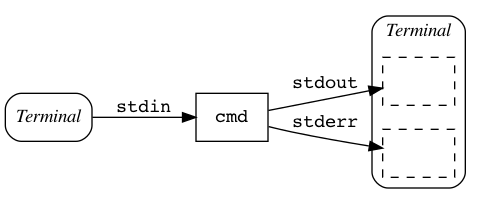
In the first command, 2>&1 means that stderr now points to where
stdout pointed to.
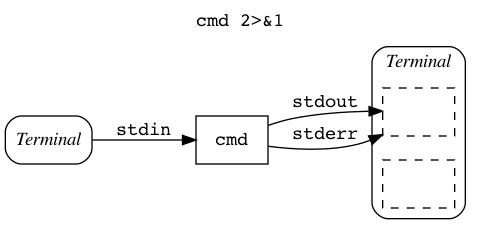
Now stdout is redirected (>file).
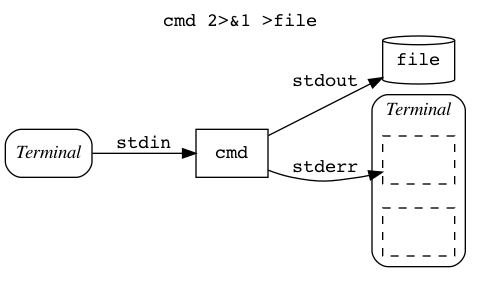
In other words:
stderrcontinues to point to the terminalstdoutpoints tofile
Standard Output Duplication After Redirection
Starting from the same initial setup

first stdout is redirected (>file).
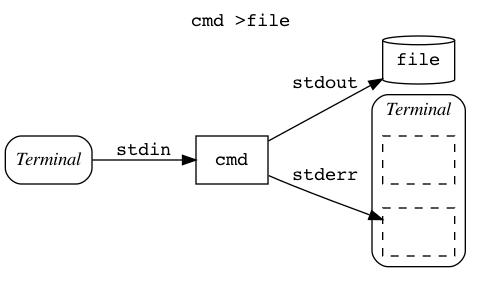
And then stderr is pointed to where stdout points at (2>&1)
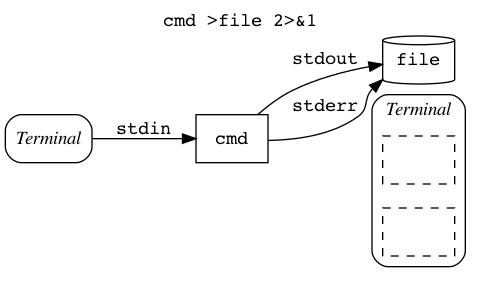
This is likely what was intended and shows why the order of the redirections matters.
Syntax for Duplicating File Descriptors
In these examples, n stands for an optional file descriptor
number. Just like for regular redirection, it is not necessary to use
0 for input and 1 for output redirection. word stands for a numeric
file descriptor, the character - to close a file descriptor
(discussed in a future post), or variables names for some shells as
mentioned in the previous post.
- Duplicate an input file descriptor:
n<&word - Duplicate an output file descriptor:
n>&word
A process has access to at least up to 20 file descriptors to identify
open files. The POSIX-compatible shells can use the special command
exec to create file descriptors and for the input example below,
assume that a file descriptor number 3 already exists that points to a
file. Explicitly listing file descriptor 0 as an input is of course
unnecessary in this somewhat contrived example.
The output example is again using duplicating stdout for stderr to
and other file descriptors are possible here as well.
| Duplicate input file descriptor | Duplicate output file descriptor | |
|---|---|---|
| POSIX | cmd 0<&3 |
cmd 2>&1 |
| bash | cmd 0<&3 |
cmd 2>&1 |
| ksh | cmd 0<&3 |
cmd 2>&1 |
| csh | n/a | n/a |
| zsh | cmd 0<&3 |
cmd 2>&1 |
Other Shells
The syntax for I/O redirection in POSIX-standard shells is arguably confusing and inconsistent. In the 10th Edition of Research Unix and the Plan 9 operating system developed at Bell Labs, Tom Duff created a new shell called
rcthat cleaned up much of the Bourne Shell’s syntax. I/O redirection in particular is more consistent. Instead ofcmd >file 2>&1, thercshell usescmd >file >[2=1].Other Unix shells exist that do not attempt to be POSIX-compliant, but I/O redirection is rarely different.
Because making stderr a copy of stdout and then redirecting it to
a file is so common an operation, many shells have shortcuts for it.
| Redirect standard output and standard error | |
|---|---|
| POSIX | cmd >file 2>&1 |
| bash | cmd &>file (preferred) or cmd >&file |
| ksh | cmd >file 2>&1 |
| csh | cmd >&file |
| zsh | cmd &>file (preferred) or cmd >&file |
It is noteworthy that the C Shell does not have the generic file
descriptor duplication of the POSIX-compatible shells. The C Shell
shortcut for redirecting both stdout and stderr does exist in Bash
and Zsh, but the “reverse” syntax of &> is preferred. This is
because of ambiguities that can arise if the redirection target
expands to, e.g., the character -.
Finally, ksh93 and Zsh support a concurrent programming construct
called co-processes. To redirect from or to the co-process, those
shell use >&p. Bash also supports co-processes and uses variable
names as redirection sources and targets.
Coming Up…
The next post will discuss closing and moving file descriptors and a
shortcut for redirections in pipelines. To wrap up file descriptor
copying, the exec special command will be explored as well.